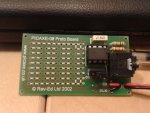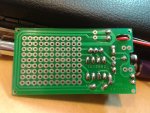I can’t tell if I’ve done something wrong or if I have a bad cable…
I know there is a lot of info here, but I am trying to be thorough… maybe I missed something simple??
I just purchased and received PICAXE-08 Starter Pack. I’ve soldered it up, loaded the USB drivers, connected the cable and I cannot get PICAXE Editor 6 to recognize my board or even my cable.
I have searched through the forum and found several similar problems, tried the solutions and tests described with still no luck. In fact I am failing some tests, but not sure what to do or how to fix. Maybe I have a short in my soldering but I think its right measures out correctly.
Ok here some specifics:
My computer: Windows 7 Ultimate 32 bit w SP1, AMD Athlon machine
I am using PICAXE Editor 6.0.6.2 (Beta)
USB drivers :
- AXE027 PICAXE USB (COM5) Revolution Edu, 3/18/2011, V2.8.14.0 with port settings all set to default 9600,N,8,1,None, Latency 16ms, Serial enumerator
- AXE027 PICAXE USB Revolution Edu, 3/18/2011, V2.8.14.0, Load VCP.
Both drivers appear top loading correctly when I pug in the cable with no errors
In the Editor I have typed in the Flashing LED program, although I have not wired any LEDs, just trying to get downloading working and I thought I would get better behavior from the application with something typed in there.
With the AXE027 USB cable connected to the correct USB port on my computer and the other end to my PICAXE starter board, and with 3 brand new AA batteries connected as my power supply, I select “PICAXE” from the top menu of the editor and select “Program/Download” from the ribbon menu. I see the editor indicating it is search for HW on COM5 and within a few seconds I see “Program Failed, Error: Hardware not found on COM5!” popup. I repeated with another set of new batteries, and a different USB port with the same result.
Troubleshooting:
First test is to see if I have communication: I connect the USB cable to the same USB port, connect the other end to my PICAXE starter board, and connect 3 brand new AA battery power supply. In the “Workplace Explorer” on the left panel on the settings tab I have the following selected, PICAXE-08M2, COM5 AXE027 PICAXE USB. I select “Check PICAXE type connected” under “PICAXE Type” and the compiler window pops up with PICAXE-08M2 V2.9, Searching for hardware on COM5. Within a few seconds I get “Firmware Check Failed, Error: Hardware not found on COM5!” popup.
Ok next test…
The following 3 tests are conducted with the cable connected to the computers USB port but not connected to my starter project board.
In the “Workplace Explorer” on the left panel I select “Configure and Test” under the “COM Port” heading” and from here I select “Test Download Cable”
During the first test, the loopback test, I select my cable, COM5, use a paper clip to connect the inner and middle rings of the jack plug and go to the following screen and see absolutely nothing in the window…
The second test is a check for power/voltage on the jack plug. With the cable still plugged into my USB port from the previous test, I remove the paper clip and connect a DVM to the outer and middle rings. No voltage is measured, I see a little oscillation in millivolts which I attributed to noise.
So those 2 tests fail, however I have something working… by accident I had left the jack cable connected to my PICAXE board during the loop back test and I see “Hello, I am your PICAXE-08M2” being repeated pumped out. So there is communication, maybe?
I tried another test.
Leave the cable connected to the USB port and remove the cable from my PICAXE starter board and put the loopback paper clip back in place. Close the “Configure and Test” and “Test Download Cable” windows. In the Editor select PICAXE from the top menu, and then select Terminal from the ribbon menu. Select COM 5, 9600, N, 8, 1, None. Also note : DSR & Break are RED, I assume this off or 0, and CTS, DTR, RTS are all GREEN. With port open, type value in transmit buffer and hit send. I see nothing in the receive buffer. Then I change DTR(Data Terminal Ready) from GREEN to RED by clicking on it. With port open, type value in transmit buffer and hit send. Wala! What I type comes back in the receive buffer.
So I have some sort of communication, but I still cannot download.
Please help.
Thanks!
Mark
I know there is a lot of info here, but I am trying to be thorough… maybe I missed something simple??
I just purchased and received PICAXE-08 Starter Pack. I’ve soldered it up, loaded the USB drivers, connected the cable and I cannot get PICAXE Editor 6 to recognize my board or even my cable.
I have searched through the forum and found several similar problems, tried the solutions and tests described with still no luck. In fact I am failing some tests, but not sure what to do or how to fix. Maybe I have a short in my soldering but I think its right measures out correctly.
Ok here some specifics:
My computer: Windows 7 Ultimate 32 bit w SP1, AMD Athlon machine
I am using PICAXE Editor 6.0.6.2 (Beta)
USB drivers :
- AXE027 PICAXE USB (COM5) Revolution Edu, 3/18/2011, V2.8.14.0 with port settings all set to default 9600,N,8,1,None, Latency 16ms, Serial enumerator
- AXE027 PICAXE USB Revolution Edu, 3/18/2011, V2.8.14.0, Load VCP.
Both drivers appear top loading correctly when I pug in the cable with no errors
In the Editor I have typed in the Flashing LED program, although I have not wired any LEDs, just trying to get downloading working and I thought I would get better behavior from the application with something typed in there.
With the AXE027 USB cable connected to the correct USB port on my computer and the other end to my PICAXE starter board, and with 3 brand new AA batteries connected as my power supply, I select “PICAXE” from the top menu of the editor and select “Program/Download” from the ribbon menu. I see the editor indicating it is search for HW on COM5 and within a few seconds I see “Program Failed, Error: Hardware not found on COM5!” popup. I repeated with another set of new batteries, and a different USB port with the same result.
Troubleshooting:
First test is to see if I have communication: I connect the USB cable to the same USB port, connect the other end to my PICAXE starter board, and connect 3 brand new AA battery power supply. In the “Workplace Explorer” on the left panel on the settings tab I have the following selected, PICAXE-08M2, COM5 AXE027 PICAXE USB. I select “Check PICAXE type connected” under “PICAXE Type” and the compiler window pops up with PICAXE-08M2 V2.9, Searching for hardware on COM5. Within a few seconds I get “Firmware Check Failed, Error: Hardware not found on COM5!” popup.
Ok next test…
The following 3 tests are conducted with the cable connected to the computers USB port but not connected to my starter project board.
In the “Workplace Explorer” on the left panel I select “Configure and Test” under the “COM Port” heading” and from here I select “Test Download Cable”
During the first test, the loopback test, I select my cable, COM5, use a paper clip to connect the inner and middle rings of the jack plug and go to the following screen and see absolutely nothing in the window…
The second test is a check for power/voltage on the jack plug. With the cable still plugged into my USB port from the previous test, I remove the paper clip and connect a DVM to the outer and middle rings. No voltage is measured, I see a little oscillation in millivolts which I attributed to noise.
So those 2 tests fail, however I have something working… by accident I had left the jack cable connected to my PICAXE board during the loop back test and I see “Hello, I am your PICAXE-08M2” being repeated pumped out. So there is communication, maybe?
I tried another test.
Leave the cable connected to the USB port and remove the cable from my PICAXE starter board and put the loopback paper clip back in place. Close the “Configure and Test” and “Test Download Cable” windows. In the Editor select PICAXE from the top menu, and then select Terminal from the ribbon menu. Select COM 5, 9600, N, 8, 1, None. Also note : DSR & Break are RED, I assume this off or 0, and CTS, DTR, RTS are all GREEN. With port open, type value in transmit buffer and hit send. I see nothing in the receive buffer. Then I change DTR(Data Terminal Ready) from GREEN to RED by clicking on it. With port open, type value in transmit buffer and hit send. Wala! What I type comes back in the receive buffer.
So I have some sort of communication, but I still cannot download.
Please help.
Thanks!
Mark






